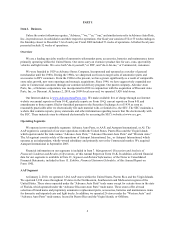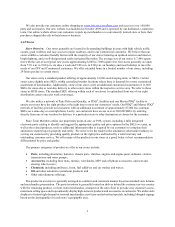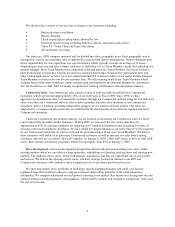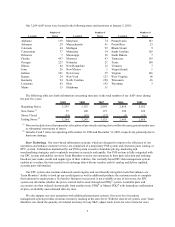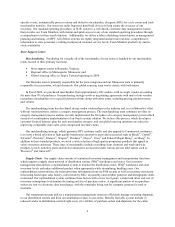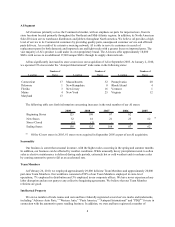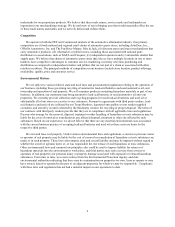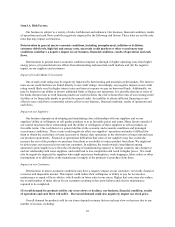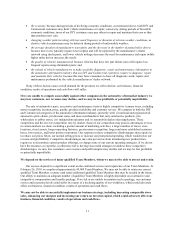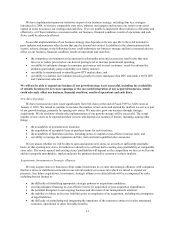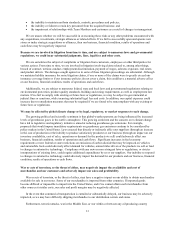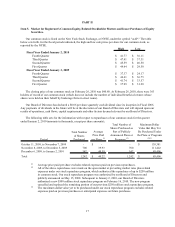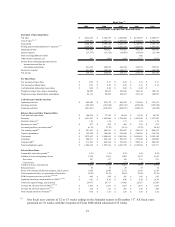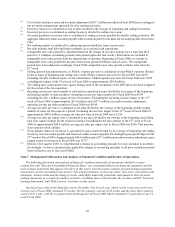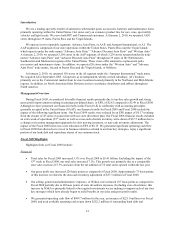Advance Auto Parts 2009 Annual Report Download - page 24
Download and view the complete annual report
Please find page 24 of the 2009 Advance Auto Parts annual report below. You can navigate through the pages in the report by either clicking on the pages listed below, or by using the keyword search tool below to find specific information within the annual report. 11
• the economy, because during periods of declining economic conditions, as mentioned above, both DIY and
Commercial customers may defer vehicle maintenance or repair; conversely, during periods of favorable
economic conditions, more of our DIY customers may pay others to repair and maintain their cars or they
may purchase new cars;
• changing weather patterns along with increased frequency or duration of extreme weather conditions, as
elective vehicle maintenance may be deferred during periods of unfavorable weather;
• the average duration of manufacturer warranties and the decrease in the number of annual miles driven,
because newer cars typically require fewer repairs and will be repaired by the manufacturer’s dealer
network using dealer parts; and lower vehicle mileage decreases the need for maintenance and repair (while
higher miles driven increases the need);
• the quality of vehicles manufactured, because vehicles that have low part failure rates will require less
frequent repairs using aftermarket parts; and
• the refusal of vehicle manufacturers to make available diagnostic, repair and maintenance information to
the automotive aftermarket industry that our DIY and Commercial customers require to diagnose, repair
and maintain their vehicles, because this may force consumers to have all diagnostic work, repairs and
maintenance performed by the vehicle manufacturers’ dealer network.
If any of these factors cause overall demand for the products we sell to decline, our business, financial
condition, results of operations and cash flows will suffer.
If we are unable to compete successfully against other companies in the automotive aftermarket industry we
may lose customers, our revenues may decline, and we may be less profitable or potentially unprofitable.
The sale of automotive parts, accessories and maintenance items is highly competitive in many ways, including
name recognition, location, price, quality, product availability and customer service. We compete in both the DIY
and Commercial categories of the automotive aftermarket industry, primarily with: (i) national and regional retail
automotive parts chains, (ii) discount stores and mass merchandisers that carry automotive products, (iii)
wholesalers or jobber stores, (iv) independent operators and (v) automobile dealers that supply parts. These
competitors and the level of competition vary by market. Some of our competitors may possess advantages over us
in certain markets we share, including a greater amount of marketing activities, a larger number of stores, store
locations, store layouts, longer operating histories, greater name recognition, larger and more established customer
bases, lower prices, and better product warranties. Our response to these competitive disadvantages may require us
to reduce our prices below our normal selling prices or increase our promotional spending, which would lower our
revenue and profitability. Competitive disadvantages may also prevent us from introducing new product lines,
require us to discontinue current product offerings, or change some of our current operating strategies. If we do not
have the resources or expertise, or otherwise fail to develop successful strategies to address these competitive
disadvantages, we may lose customers, our revenues and profit margins may decline and we may be less profitable
or potentially unprofitable.
We depend on the services of many qualified Team Members, whom we may not be able to attract and retain.
Our success depends to a significant extent on the continued services and experience of our Team Members. At
February 26, 2010, we employed approximately 49,000 Team Members. We may not be able to retain our current
qualified Team Members or attract and retain additional qualified Team Members that may be needed in the future.
Our ability to maintain an adequate number of qualified Team Members is highly dependent on an attractive and
competitive compensation and benefits package. If we fail or are unable to maintain such a package, our customer
service and execution levels could suffer by reason of a declining quality of our workforce, which could adversely
affect our business, financial condition, results of operations and cash flows.
We may not be able to successfully implement our business strategy, including increasing comparable store
sales, enhancing our margins and increasing our return on invested capital, which could adversely affect our
business, financial condition, results of operations and cash flows.



